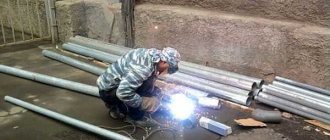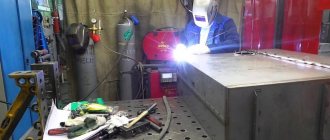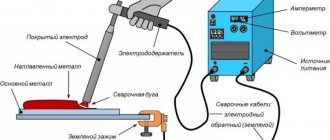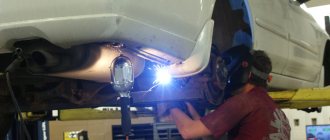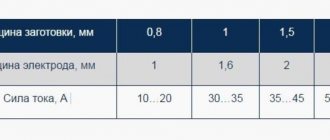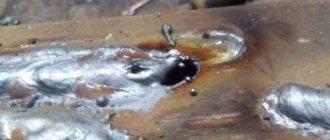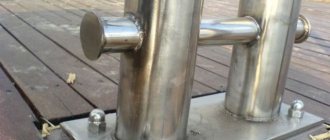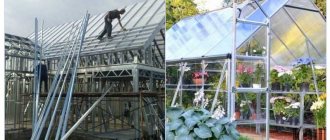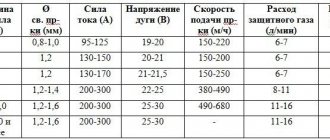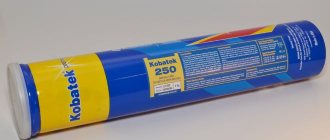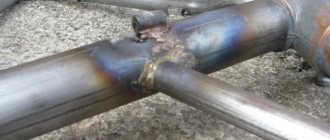The process of joining two metal workpieces ceased to be a problem after the advent of the welding machine. Some difficulties still remain. For example, it is not easy for beginners to do the job of welding two thin metal sheets in good quality. The article examines in detail the question of how to properly weld thin metal using electric welding. Looking ahead a little, it is worth saying that to perform such operations, technologies and equipment are used that allow the work to be completed without deforming the welding sheet and burning out the working area.
How to carry out the procedure with thin-walled objects
Let's assume that the thickness of the workpiece is 1-1.5 mm. It is quite difficult to select an electrode for it, because it must have an even smaller cross-section (according to unspoken rules). Is it really 0.7-0.9 mm? You won’t be able to find such consumables on sale; they simply don’t exist; standard rulers start at 2–3 mm. Yes, one and a half ones are also available, you can buy them, but they are also uncomfortable for beginners to work with.
To solve the problem, you need to use special equipment that generates direct current under high voltage. It is easy to adjust, and with its help it is quite possible to ensure excellent seam quality.
Conclusion
In the article we looked at the main points about how to weld thin metal with an inverter. To do this, we prepare the workpieces according to the instructions, remove excess temperature, prepare a selection of tools, set the current and begin work . At the time of welding, special attention must be paid to the quality of the seam; for this, it is necessary to remove the electrode for a few seconds from time to time to prevent burn-through, and it is also necessary to use heat-removing plates with wire. Only practice can help in mastering these processes.
Technology for welding thin metal with an inverter for beginners
To achieve a decent result while maintaining occupational safety, you must adhere to a few simple rules:
- Clean the joints from dirt and possible rust (even if you see that there is no corrosion, just in case).
- Securely secure the workpieces so that they do not move out during the process.
- Preliminarily outline the connection line, so as not to get lost later and not to disturb the desired geometry - with dots every 5–7 cm.
- Complete the work as quickly as possible - without delays in any areas, in one pass.
- Set the minimum current strength - if the device has a smooth adjustment function, this will not be difficult.
- Monitor the open circuit voltage - it is important that it remains at least 70 V.
The main difficulties of welding thin sheet metal
There are certain processing specifics that beginners should take into account:
- The progress and result of the process are extremely dependent on the parameters of the electrode. It is necessary, firstly, to correctly select it in size, and secondly, to drive it smoothly, at the same speed, with zigzag movements (more on this below). Otherwise, burns cannot be avoided.
- The bath should not be very large so that it does not load the seam with its weight and does not push it through. Otherwise, you risk seeing roller-like sagging on the reverse side of the product (although the front side will look quite aesthetically pleasing).
- When talking about how to properly weld thin metal with an electrode, we must not forget that due to inexperience, the material is very easy to overheat, and then it becomes deformed. In the zone of excessive thermal influence, stretching occurs and waves are formed; if the product is faulty, it is permissible to straighten it with a rubber hammer; if not, the only option for correcting the defect is to apply a new seam overlapping the one already made.
- The passage must be done quickly, but at the same time it is important not to rush, because haste is fraught with insufficient penetration, violating the tightness of the finished product (up to its complete unsuitability), which is especially critical in the production of various containers for filling liquids.
Tools and materials
In the case of gas welding, the most justified solution would be to choose acetylene technology. In this case, the only additional components you will need are wire and flux. To influence the intensity of the fire, a special reducer is used. Gas welders use:
- special welding tables;
- cylinders with gas obtained at the plant and/or gas generators;
- hoses for supplying gaseous components;
- accessories for assembling welded products;
- other tools that they deem necessary for themselves.
For manual arc welding, the following is required:
- apparatus;
- electrodes;
- power wires;
- special transformers;
- protective masks, gloves and shields;
- slag hammer;
- magnetic square;
- trolleys for devices;
- standardized samples for ultrasonic flaw detection;
- welding compounds;
- collet holders.
Selection of modes and conductors: polarity
Considering how to weld thin sheets of metal with an inverter, it should be said that it is better suited for this work than a transformer. Why? Because with its help it is easier to set the desired characteristics and, more importantly, adjust them in the process of creating seams.
So what amperage should you choose? This directly depends on the walls of the workpiece, as well as on the cross-section of the filler rod. We present the current ratio in the table below.
| Part thickness | Electrode diameter | Current strength |
| mm | A | |
| 0,5 | 1 | 10–20 |
| 1 | 1–1,6 | 30–35 |
| 1,5 | 2 | 35–45 |
| 2 | 2,5 | 50–65 |
| 2,5 | 2–3 | 65 |
Here it is worth clarifying which metal is considered thin in principle. We answer, up to 5 mm - this is an official, but too vague definition. After all, even the table hints that problems arise when processing parts that are no thicker than 2-2.5 mm.
If a beginner clearly needs to focus on the above dependence, then an experienced specialist will often select the optimal mode “by eye”. Although he also needs to remember about one pass at a time, because modern additives are distinguished by the fact that they melt relatively quickly, which means you need to be careful with them.
Technology and training
Workwear for welders
The process of welding metal, both by electric welding and by other methods, begins with the selection of work clothing and equipment. For electric welding you need:
- mask or goggles for eye protection with a special light filter;
- gloves, preferably suede;
- long sleeved clothing;
- closed shoes.
From equipment:
- welding machine;
- transformer for converting alternating current into direct current;
- electrodes included;
- hammer and other tools for knocking down slag and cleaning the seam.
Welding kit: protective mask, apparatus and electrodes
Learning how to weld metal using electric welding correctly depends on the selection of equipment, and, first of all, electrodes. The quality of welding depends on their coating or coating. Under the influence of temperature, the coating turns into a gas zone above the bath of molten metals of the base and electrode, which prevents the influence of air on the process of their fusion.
It is better to gain experience in welding work under the guidance of a professional mentor, because often the choice of equipment, its mode of operation, consumables, placement of elements to be connected, speed of arc movement, and so on occurs empirically, that is, by trial. With experience will come skills, uniformity of movement, quality of edges and seams.
The right technology: how to weld thin metal using electric welding
According to the recommendations, this problem needs to be solved in 3 stages:
- Take preliminary measures.
- Connect the parts.
- Clean the seams.
The selection of equipment is carried out mainly for the first two steps, which is why they deserve the closest attention and detailed consideration.
Preparatory work
They boil down to cleaning all contact surfaces of the joint from any possible types of contamination. Particular attention must be paid to the installation point of the supporting part of the apparatus.
Corrosion stains should be carefully removed with sandpaper. It is also better to remove the zinc coating (if any) using a grinder, although if time is pressing, you can leave it in the expectation that it will melt when heated. But it is still recommended to remove it so as not to create unnecessary irregularities.
Working with galvanized steel
Welding thin-walled galvanized steel, or galvanized steel as it is called, causes welding difficulties. What is galvanized steel? Ordinary steel, as a rule, is sheet, with a zinc coating, which creates difficulties during welding.
The zinc coating does not allow making a high-quality seam, so it must first be removed from the edges.
This is done using sandpaper, a grinder, an angle grinder, or a metal brush.
An important condition for such work is that cleaning must be done outdoors or in a well-ventilated room. During stripping, zinc can evaporate and its fumes are toxic.
Fulfillment of all the listed conditions - the correct selection of equipment and components, an optimally configured machine, a successful choice of welding method, compliance with the rules of safe welding - all this will help you achieve the desired result.
Do-it-yourself welding of thin metal with an inverter
It is necessary to adhere to the following algorithm:
- Clear the end of the electrode (approximately 5 mm) from the coating - for the fastest possible ignition.
- Make a short-term fire and pinpoint the material along the entire seam line, at intervals of 5–7 cm - this will help prevent possible deformation.
- To ignite an arc for continuous use, simply strike the filler rod against the metal or tap it. Maintain a flame length of 2–3 mm and a distance corresponding to the cross-section of the consumable (see table).
- Make a bath of melt, trying to keep it an elongated oval shape, and start making a seam - then it will most likely turn out to be of high quality.
- Carry out the passage smoothly and quickly, without bringing the conductor closer to the part to avoid drops.
When discussing how to weld thin metal (iron) with an inverter for beginners, we always advise using a machine with arc forcing and anti-stick functions. It is more convenient than usual, because it regulates the process and automatically adds tension when the flame stretches excessively or releases it when the filler rod gets dangerously close to the workpiece.
In addition, to ensure a high-quality result, you should adhere to the following rules:
- Position the holder so that it is at a 60-degree angle to the surface and does not block the view of the seam and the bath. If you tilt it too much, the joint will be bulging and uneven.
- Monitor the speed of movement, trying to maintain a uniform and progressive motion.
- Move the electrode from bottom to top (for vertical joints) or from left to right (for horizontal joints); the trajectory should be zigzag.
Knowing how to properly weld thin metal using inverter welding, do not forget that after the operation is completed, the joint should be carefully inspected: clean off the slag and make sure there are no burns or lack of penetration.
Welding technique
Welding thin-sheet iron requires proper approach of the edges of the plates to each other. Butt joints often result in burn-throughs and are only suitable for experienced welders. If possible, it is worth placing the plates overlapping. This will create some basis for the deposited metal, and will not allow burning through the entire product. In this case, the electrode is directed primarily to the bottom plate, since a different position will lead to undercuts on the top side.
When joining into a butt, the edges are not cut. There is no need for a gap either. It is necessary to bring the ends of the parts together as tightly as possible and tack. Low current strength and thin electrodes make the work much easier. You can then cook it in several ways:
- Set the current to low and quickly sew the seam without oscillating movements, strictly along the connection line.
- Raise the current a little higher, but conduct the seam with an intermittent arc, giving the metal time to cool before the next “portion” of the additive.
- Cook using the methods described above, but using a special substrate to maintain a heated area and avoid sagging. A metal table will not work here, since the product may be partially welded to it. A good alternative would be a graphite backing.
- To prevent severe deformation, apply stitches in a checkerboard pattern, or in small sections (100 mm each). With the latter method, it is necessary to finish the next seam at the beginning of the previous one. This will allow the product to be heated evenly along its entire length and minimize deformation.
Welding is carried out with a short arc, which allows you to quickly form a seam and avoid overheating of the area. Increasing the distance between the end of the electrode and the surface visually prevents burning of the plates, but does not contribute to the formation of a welding bead. The electrode is held towards itself at an angle of 45 degrees, or tilted to the side. Right angles should be avoided as this leads to burns.
https://www.youtube.com/watch?v=P2CzIuF_VhQ
Converter operation
This is a device with reverse polarity, that is, it is connected to the workpiece with a minus, and to the conductor with a plus. This eliminates the very possibility of defects occurring. The rod heats up stronger and faster than the material at the point of contact, especially if this consumable is of good quality (from a foreign company, with known properties, proven in practice). It is also important that it has high buoyancy and its diameter does not exceed 2 mm.
There are many videos showing how to perform passes. Check out some of them and you'll avoid making common mistakes.
Advantages of thin-walled blanks
Welded strictly according to technology, using modern equipment, with neat seams, they:
- They have an aesthetic and even attractive appearance, because there is no scale on their surfaces.
- Exactly correspond to the design dimensions, not deformed, since during their production the material was not subject to temperature changes.
- They are completely ready for painting or other coatings because there is no slag on them.
- They can boast of a strictly planned shape, without holes, depressions or tubercles, if the stress during their manufacture was constant.
The parts have all the described advantages because they are manufactured using advanced equipment, the only drawback of which is possible interruptions when working in conditions of very sub-zero temperatures. But this is, in principle, typical for any technology of this kind.
Features and advantages of welding a car body with an inverter
Inverters are high-tech equipment, which, meanwhile, is quite simple to operate, for example, in terms of training in welding technologies (the training period does not exceed one week for beginners). These devices are also distinguished by high productivity, which makes this type of welding equipment especially common in welding work on automotive equipment.
Inverter welding machines themselves have a number of advantages, including:
- rapid heating of the metal being welded;
- no dependence of the device’s performance on the stability of the electrical network in terms of maintaining voltage;
- economical operation of the device in terms of electricity consumption (compared to a semi-automatic device, the inverter absorbs 20% less electricity);
- low values of molten and burned metal during the welding process;
- relative ease of use (compared to semi-automatic devices).
However, it should be understood that inverters are in the same price range as semi-automatic devices, and in some cases they can exceed it in cost (depending on the brand used).
How to arc weld thin galvanized metal
The secret is to completely remove the coating from the edges before making the joint. This can be done either manually or with a grinding machine. With proper experience, the second option is preferable, as it will require less time and physical effort.
You can also burn out the ends of the parts, but this is not the best option. Remember that when heated, zinc vapors begin to be released, and they are poisonous and can provoke quite severe poisoning. Therefore, processing of workpieces must be carried out either in the fresh air or in a room with good ventilation, and always in special clothing.
Formation of a standard welding seam using an inverter
It is necessary to connect parts during welding so as not to change the speed of movement of the electrode, otherwise it will not be possible to form an even seam. The liquid state of the weld is much lower than the main part of the metal.
The resulting arc is capable of capturing the entire base metal, moving the entire pool to its original place, forming a welding seam. The welder's job is to position the weld in a straight line with the metal. By creating zigzags and describing arcs with your hands, you can easily create an even seam.
The entire welding process depends on the quality of the electrode.
In such cases, it is necessary to constantly keep in mind the dimensions of the location of the weld. It is worth trying and positioning the bath strictly in a circle. A uniform rocking motion creates a seam, but you must watch for it to form at one edge of the metal plate and then control its formation at the top of the tub.
By directing the electrode closer to the metal workpiece, a raised seam is formed. Most welders achieve a flat weld and movement of the pool by significantly changing the angle of the electrode. The best option: control the angle of inclination within 45-90° to form an ideal seam and control the bathtub.
Possible problems when welding sheet metal with an electrode
During the process, defects may arise that are similar to ordinary defects, but are caused precisely by the small thickness of the products. Among them:
- Sticking - observed if you bring the tip of the rod too close to the surface being treated; Another common cause is low amperage, and either of these will result in an uneven weld.
- Burning - occurs when there is an excess of power, if you set too much current. As a result, the material melts and pits and depressions appear on the smooth surface.
- Lack of penetration - this is often done by beginners who hold the rod far from the part for fear of making a hole. As a result, the additive is not hot enough and spreads over the part, and when it hardens, it forms a lump that needs to be cleaned off. And, most importantly, there is no high-quality connection either.
- Deformation - appears if the temperature at the point of thermal impact is too high, causing the plane to collapse or bend.
How to avoid such problems? This is clear from their description: firstly, you need to adhere to the technique of performing the pass, and secondly, set the correct operating parameters.
Welding techniques and methods
For welding thin sheets of metal, semi-automatic models of welding machines, as well as manual arc units, are suitable. It is much easier to work with a semi-automatic machine, since some of the welding processes are automated. This allows you to overcome some of the difficulties when working with thin sheet metal.
The advantage of semi-automatic machines is also the absence of the need to change electrodes during operation, because the wire is fed stably
This speeds up the work process, which is extremely important when carrying out large-scale projects.
On a note! For domestic purposes, for non-volume operations, craftsmen often use manual arc welding due to its low cost and the ability to make the unit with their own hands.
When welding thin sheets of metal, it is important not only to have good equipment, but also to understand how to weld such material. Scheme of welding a thin sheet of metal
Scheme of welding a thin sheet of metal.
There are different welding techniques and methods that are relevant for this case:
When performing continuous welding of an entire seam, it is important to select the correct current. Optimal range - 40-60 A
It is equally important not to make a mistake with the speed of moving the electrode for welding thin metal. If you move too quickly, the root of the weld may not be welded through. And if you move too slowly, the metal surface can become covered with holes. Intermittent welding is also called spot welding. It is used more often than other technologies in the case of thin sheet metal. To implement this technology, thin electrodes are required, with one end of which dots are placed on the metal or short lines are drawn with equal spacing.
On a note! The peculiarity of intermittent welding is that even very thin metal sheets can be welded this way. The main thing is to set the welding current a little higher than usual, and to achieve rapid movements in order to prevent the material being welded from cooling down.
Experienced welders recommend adhering to the following rules when working with manual units and thin sheets of metal:
High-quality welded joints can be obtained subject to constant monitoring of the parameters of the weld from all sides during the process of electric arc welding with an inverter. When working, it is important to keep the electrical conductor as close to the metal surface as possible until a red spot appears on it. It is direct evidence that there is a metal drop under the electrical conductor, due to which the metal sheets are connected.
Advantages of welding thin workpieces with an inverter
This method allows you to make a high-quality connection of thin metal. If welding work is carried out by a professional, then temperature deformation does not occur and the product will have an aesthetic appearance. With direct current, thin products can be cooked with less current, so the likelihood of burnout is significantly reduced.
The microprocessor control of such a device allows you to eliminate “holes” and voltage failures, generating an ideal output current that is suitable for welding work.
Necessary conditions for arc welding thin metal
Quite strict requirements are imposed on both the device and consumables.
Thus, it is recommended to use electrodes with the following parameters:
- diameter – less than the thickness of the workpiece, the optimal cross-sectional size is considered to be 1.6 mm;
- the material of manufacture is the same as the part;
- coating made of refractory materials;
- the manufacturer is a well-known company (in principle, any brand is acceptable, but it is better to choose quality, the difference in price is usually insignificant).
In addition, the equipment must be suitable:
- It’s better if the inverter is semi-automatic - it’s more convenient to use than a manual one, if only because you don’t have to spend physical effort keeping it on;
- it is more practical if it has a wide adjustment range, 10–15 A, this will allow flexible adjustment of the current supply based on the parameters of the conductor.
But any model is definitely more productive than a transformer, because the efficiency is on average 90%, and this is with modest electricity consumption.
How to choose a device
All seams made on inverter welding machines are visible. And the quality of such seams depends on what characteristics a particular device has. When choosing an inverter, you should consider the following parameters:
- resistance to unstable voltage : stability coefficient (protection coefficient) must be in the range from 20 to 25% (indicated on the device itself and in its documents);
- maximum permissible ambient temperatures at which the equipment must be operated (indicated in degrees Celsius and in the range from +40 to -40 degrees, which are optimal temperature values);
- values of the diameters of the electrodes used during welding (in particular, electrode No. 2 with a diameter of 2 mm is used for welding thin parts, for example, body metal on the fenders or doors of a car, and electrodes No. 4 with a thickness of 4 mm are used on thicker component elements of the car body) .
Approximate cost of inverters for welding on Yandex.market
You should not pay attention to the “hot start” or “anti-stick” functions, since they are initially included in all modern inverter machines in the “base” and are used by manufacturers as an advertising ploy in order to better present their product for inexperienced users.
Inverter device
Speaking of how to weld thin metal with an electrode, we note that relatively complex equipment is used for this. This is a device that must support at least several modes, each with its own frequencies and other operating parameters. To ignite the flame, it must also convert the current twice - first to direct from alternating, and then to high-frequency.
The general scheme and principle of its operation are as follows:
This shows the nature of the change in momentum. The wave passes through the bridge, the filter capacitor, the inverter itself, enters the transformer and conductor and only after that creates the necessary heating.
To make it easier for a beginner to figure out how to weld thin metal using electric welding, the body of the device must have a modern level of ergonomics. To do this, it must contain the following structural elements:
- toggle knobs - for smooth adjustment of the current strength in the required range;
- indicators - mains, overheating protection;
- connectors – for connecting cables with a cross-section of 50 sq mm or less.
In the design adopted today, its body is necessarily equipped with side ventilation grilles - for quick cooling - and, optionally, a belt for easy carrying on the shoulder.
Selecting a welding helmet
As we mentioned at the beginning, when welding at low currents, the light from the arc is less bright, so the joining line is difficult to see. Due to insufficient lighting, you can even put a stitch bypass. It is more convenient to weld thin metal with coated electrodes in chameleon masks with a darkening range of 4-8 DIN or 9-13 DIN.
Unlike a mask with a conventional light filter, in a chameleon you can precisely point the tip of the electrode at the junction. This reduces the number of “bunnies” and helps keep the front surface of the product clean. Adjustable darkening power from 4 to 8 DIN makes it easy to adjust to different low welding currents.
We recommend buying a BARSVELD MS 307 mask with ASF-707 with a range of 5-8 and 9-13 DIN, which has a large viewing window of 98x87 mm. Thanks to this, a good overview is maintained in all spatial positions. Full Color technology conveys everything in natural colors and it will be easier for a beginner to distinguish the molten slag of the electrode coating from the liquid metal. The price of the mask is a little more than 5,000 rubles, which makes it quite affordable even for household welding in a garage or country house.
Techniques for structures with thin walls
There are several techniques that help you avoid errors with defects. So, here are the ways to weld thin metal with an electrode:
- Pointwise - you need to make a large number of local sticks, every 5-7 cm. Light the arc, make a connection in a specific place and extinguish it. This option is good for its accuracy, but its implementation takes a lot of time.
- Overlapping - it is necessary to place two workpieces on top of each other so that the edge of the upper one overlaps the end of the lower one, and process it. The main thing is to prevent burns and immediately clean off all the scale (if it appears at all). A relatively simple look, but associated with a large amount of time and material; But you don’t have to be afraid of through holes - they won’t impair the reliability of the structure.
- According to the selected electrode - here you need to quickly remove the coating over the entire surface of the rod, and then lay it in the direction of the planned seam. The passage is standard - smooth and fast - but the contact areas should still be given maximum attention.
When discussing how to properly weld thin metal using inverter welding, it is important to remember several nuances. If the parts are large, ignition should be carried out on parts with thick walls and from there the newly formed seam should be transferred to the butt section.
To remove heat, copper wire is often used - it boasts an impressive capacity. Although in practice it is a really capacious material that perfectly prevents melt leakage or burning.
Let's sum it up
This matter has its own specifics, there are many methods, and each of them, with its own characteristics, you just need to remember. In the process of performing a technological operation, it is important to avoid haste or delay. But the result is impressive - an aesthetically pleasing object that does not leak, without cracks or chips.
Now that you know how to weld thin metal using electric welding, you can immediately purchase consumables and start working. will help you with this - we sell bandsaw machines, to clarify the information you are interested in, contact our managers at the contact numbers listed on the page. Select conductors, set the mode, start solving the problem, armed with knowledge about this equipment. Contact Rosta LLC if you decide to buy devices for industrial use. We have manual and semi-automatic band saws in stock and on order, as well as pendulum, vertical and two-post units. To contact our specialists, call the contact numbers listed on the page.
